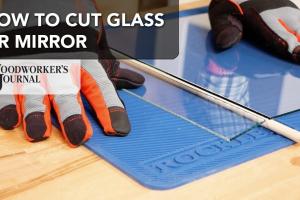Mastering the Art of Cutting Mirrors: A Comprehensive Guide

-
Quick Links:
- 1. Introduction
- 2. Understanding Mirrors
- 3. Tools Needed for Cutting Mirrors
- 4. Safety Precautions
- 5. Step-by-Step Guide to Cutting Mirrors
- 6. Case Studies
- 7. Expert Insights
- 8. Common Mistakes to Avoid
- 9. FAQs
- 10. Conclusion
1. Introduction
Cutting mirrors can seem daunting, but with the right tools and techniques, it becomes a manageable DIY project. Whether you're aiming to create a custom piece for your home decor or need a specific size for a frame, understanding the process is key. This guide will walk you through everything you need to know about cutting mirrors safely and effectively.
2. Understanding Mirrors
Mirrors are made from glass and coated with a reflective material, typically silver or aluminum. Understanding the structure of a mirror can help you appreciate how to cut it without damaging the reflection or the glass itself. The thickness of the glass, the type of backing, and the reflective coating all play roles in the cutting process.
3. Tools Needed for Cutting Mirrors
Before you start, gather the following tools:
- Glass cutter
- Straight edge or ruler
- Protective gloves
- Safety goggles
- Marker or grease pencil
- Cutting mat or a soft surface
- Clamps (optional)
4. Safety Precautions
Safety should always be your top priority when working with glass. Here are essential safety tips to follow:
- Wear safety goggles to protect your eyes from glass shards.
- Use gloves to prevent cuts from sharp edges.
- Work in a well-lit area to clearly see your cuts.
- Keep your workspace clean to avoid accidents.
5. Step-by-Step Guide to Cutting Mirrors
Follow these detailed steps to cut your mirror:
Step 1: Measure and Mark
Determine the size you want your mirror to be. Use a marker to indicate where you will cut. Ensure your measurements are accurate.
Step 2: Secure the Mirror
Place the mirror on a soft surface (like a cutting mat) to avoid damaging it. Use clamps to hold it in place if necessary.
Step 3: Score the Glass
Using a glass cutter, score the surface of the mirror along your marked line. Apply even pressure and make a single, continuous line.
Step 4: Snap the Glass
With the scored line facing up, gently apply pressure on either side of the score until the glass snaps along the line.
Step 5: Smooth the Edges
Use a glass file to smooth any rough edges to prevent injuries.
6. Case Studies
Numerous DIY enthusiasts have successfully cut mirrors for various projects. For instance, a homeowner transformed an old dresser by adding a custom-cut mirror top.
7. Expert Insights
According to glass cutting experts, the key to a successful cut is patience and precision. They recommend practicing on scrap pieces before tackling your main project.
8. Common Mistakes to Avoid
Here are some pitfalls to avoid:
- Rushing the scoring process can lead to uneven cuts.
- Not using protective gear can result in injuries.
- Failing to measure accurately can waste material.
9. FAQs
What type of glass cutter is best for mirrors?
A manual glass cutter with a carbide wheel is ideal for cutting mirrors.
Can I cut mirrors without special tools?
While it's possible, using a glass cutter ensures cleaner cuts and reduces the risk of breakage.
How thick can I cut mirrors?
Most glass cutters can handle mirrors up to 1/4 inch thick comfortably.
What should I do if the mirror breaks?
Wear gloves, clean up the pieces carefully, and dispose of them safely.
Is it safe to cut mirrors indoors?
Yes, as long as you follow safety precautions and work in a clean, controlled environment.
Can I use a regular glass cutter for mirrors?
Yes, a regular glass cutter works well for mirrors, but ensure it's sharp for the best results.
What if my cut is not straight?
If your cut is not straight, you can use a glass file to even the edges.
Can I cut a mirrored surface without damaging the backing?
Yes, if you score carefully and use the right technique, the backing can remain intact.
How do I clean the edges after cutting?
Use a glass file or a sanding block to smooth the edges.
What’s the best way to dispose of broken mirror pieces?
Wrap the pieces in newspaper and place them in a sturdy box before disposing of them in your trash.
10. Conclusion
Cutting mirrors is a skill that can be learned with practice and the right tools. By following this comprehensive guide, you can create custom mirror shapes that fit your design needs while ensuring safety and precision. Happy crafting!